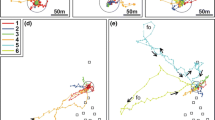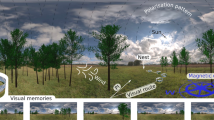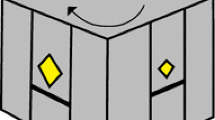Abstract
Bees of several genera make foraging trips on which they visit a series of plants in a fixed order. To help understand how honeybees might acquire such routes, we examined whether (1) bees learn motor sequences, (2) they link motor instructions to visual stimuli, (3) their visual memories are triggered by contextual cues associated with the bees' position in a sequence.
-
1.
Bees were trained to follow a complex route through a series of obstacles inside a large, 250 cm by 250 cm box. In tests, the obstacles were briefly removed and the bees continued to fly the same zig-zag trajectory that they had when the obstacles were present. The bees' complex trajectory could reflect either the performance of a sequence of motor instructions or their attempt to reach fixed points in their environment. When the point of entry to the box was shifted, the bees' trajectory with respect to the new point of entry was relatively unchanged, suggesting that bees have learnt a motor sequence.
-
2.
Bees were trained along an obstacle course in which different flight directions were associated with the presence of different large patches of colour. In tests, the order of coloured patches was reversed, the trajectory followed by the bees was determined by the order of colours rather than by the learnt motor sequence suggesting that bees will readily link the performance of a particular trajectory to an arbitrary visual stimulus.
-
3.
Bees flew through a series of 3 similar compartments to reach a food reward. Passage from one compartment to the next was only possible through the centre of one of a pair of patterns, e.g. white + ve vs. black — ve in the first box, blue + ve vs. yellow -ve in the second, vertical + ve vs. horizontal — ve in the last. In some tests, bees were presented with a white vs. a vertical stimulus in the front compartment, while, in other tests, the same pair of stimuli was presented in the rear compartment. Bees preferred the white stimulus when tested in the first compartment, but chose the vertical stimulus in the last compartment. Bees reaching a compartment are thus primed to recall the stimulus which they normally encounter there.
We argue that the elements which are linked together to form a route are “path-segments”, each of which takes a bee for a given distance in a given direction.
Similar content being viewed by others
References
Collett TS (1992) Landmark learning and guidance in insects. Phil Trans R Soc Lond B 337:295–303
Collett TS (1993) Route following and the retrieval of memories in insects. Comp Physiol Biochem 104A:709–716
Collett TS, Kelber A (1988) The retrieval of visuo-spatial memories by honeybees J Comp Physiol A 163:145–150
Collett TS, Dillmann E, Giger A, Wehner R (1992) Visual landmarks and route following in desert ants. J Comp Physiol A 170:435–442
Dingle H (1965) Turn alternation in bugs on a causeway as a delayed compensatory response and the effects of varying inputs and length of straight path. Anim Behav 13:171–177
Frisch K von (1967) The dance language and orientation of bees. Oxford Univ Press, London
Heinrich B (1976) Foraging specializations of individual bumblebees. Ecol Monogr 46:105–128
Janzen DH (1971) Euglossine bees as long-distance pollinators of tropical plants. Science 171:203–205
Kelber A (1989) Die Bedeutung von Kontextinformation für das Erinnern von Dressurmarken und Mustern bei der Honigbiene (Apis mellifera). Diplom Thesis, Univ Tübingen
Manning A (1956) Some aspects of the foraging behaviour of bumblebees. Behaviour 9:164–201
Menzel R (1990) Learning, memory and “cognition” in honeybees. In: Kesner RP, Olton DS (eds) Neurobiology of comparative cognition. Lawrence Earlbaum, Hove, pp 237–292
Müller H (1882) Versuche über die Farbenliebhaberei der Honigbiene. Kosmos 12:273–299
Müller M, Wehner R (1988) Path integration in desert ants, Cataglyphis fortis. Proc Natl Acad Sci USA 85:5287–5290
Wehner R (1981) Spatial vision in arthropods. In: Autrum H (ed) Handbook of sensory physiology, vol VII 6C. Springer, Berlin Heidelberg New York, pp 287–616
Wehner R, Menzel R (1990) Do insects have cognitive maps? Annu Rev Neurosci 13:403–414
Weiss K (1953) Versuche mit Bienen und Wespen in farbigen Labyrinthen. Z Tierpsychol 10:29–44
Weiss K (1954) Der Lernvorgang bei einfachen Labyrinthdressuren von Bienen und Wespen. Z Vergl Physiol 36:9–20
Woodworth RS, Schlosberg H (1955) Experimental psychology. 3rd ed, Methuen, London
Author information
Authors and Affiliations
Rights and permissions
About this article
Cite this article
Collett, T.S., Fry, S.N. & Wehner, R. Sequence learning by honeybees. J Comp Physiol A 172, 693–706 (1993). https://doi.org/10.1007/BF00195395
Accepted:
Issue Date:
DOI: https://doi.org/10.1007/BF00195395




